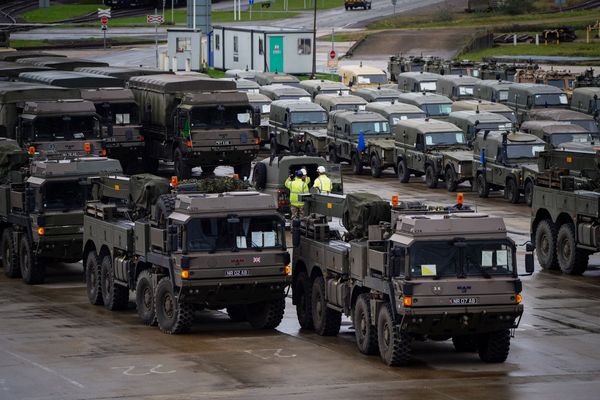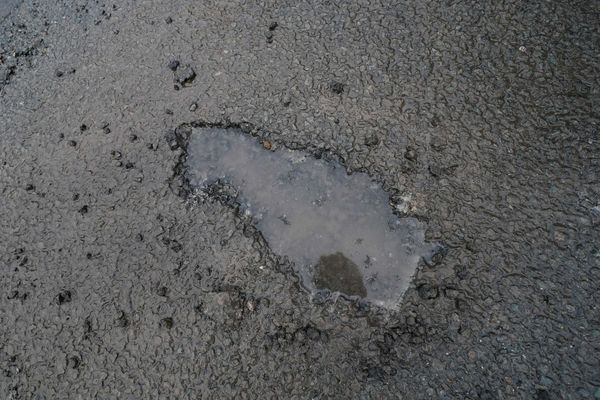
Coal heavers wear sandwich boards to protest against low wages in 1921. Hulton Archive/Getty Images
No word is invoked more to characterize the current era than “crisis.” The term has been wielded incessantly in 2020—already the most tumultuous year since 1968 and still only half over—to designate a series of new and ongoing plights. It has named the “impeachment crisis” and the “constitutional crisis” many thought it revealed, themselves signs of the “crisis of polarization” in U.S. politics. Crisis nearly always describes the coronavirus pandemic and the economic turmoil it has unleashed. Journalists speak of a “crisis of police violence” against Black people in the United States, a slow-burn tragedy that sparked a “crisis of civil unrest” after the killing of George Floyd. And Americans move nervously toward a presidential election whose results, regardless of the outcome, will be thrown into doubt by accusations of foreign meddling or partisan hijacking. A “crisis of legitimacy,” perhaps even a “crisis of emergency powers,” looms on the horizon.
Yet these problems, as awful and intractable as they are, add layers to an already familiar crisis atmosphere: There is also the environmental crisis, the health care crisis, the energy crisis, the housing crisis, the drug crisis, the debt crisis, the migrant crisis, the education crisis, and the marriage crisis. There is even a loneliness crisis.
None of these problems can be isolated; each extends into other domains embroiled in their own dysfunction, with the result that the world feels entangled in overlapping and intersecting crises.
How is it, then, that the term “crisis” should apply across so many fields—foreign affairs, domestic politics, climate, culture, economics, to name only a few? Does “crisis” have any meaning, beyond just a catch-all term for “trouble”? Is there any logic, or novelty, to the constant proclamations of crisis?
Scenes from 2020’s crises, clockwise from left: Activists in Brazil dig 100 mock graves symbolizing deaths from COVID-19 in Rio de Janeiro on June 11 to protest against Brazil’s governance during the pandemic; the Swedish climate activist Greta Thunberg takes part in a Youth Strike 4 Climate protest march in Brussels on March 6; migrants wait on the Turkish side of the Greece-Turkey border on March 2; and a couple hugs and cries next to a makeshift memorial to George Floyd, near the site where he died in police custody, in Minneapolis on June 6. CARL DE SOUZA/JOHN THYS/SAKIS MITROLIDIS/KEREM YUCEL/AFP via Getty Images
Historians are well suited to address such questions, given their training in alertness to context, eye for continuity and change, and ornery eagerness to question the terms of debate. Perhaps no part of the historian’s guild is better placed to ponder the meaning of crisis than historians of Germany, a nation whose atrocities and traumas, and willingness to grapple with their meaning, are unsurpassed in modern times. Above all, it is Weimar Germany—poised between the catastrophe of World War I and the even greater calamity of Nazism and the Holocaust—that has been portrayed as the quintessential “society in crisis.”
Weimar is much invoked nowadays, by pundits and experts alike. This commonly involves the search for parallels between that time and today, as though such correspondences might predict humanity’s future. Will democracy collapse? Will fascism return? Are protesters toppling statues a “totalitarian political movement,” as Tucker Carlson claimed? Is Trumpism?
What research by historians of Germany suggests, however, is that the deepest similarity between Weimar and today is not in any particular danger; rather, it is in the outsized role that fear, apocalyptic expectation, and longings for salvation play in the population’s political imagination.
Research on Weimar Germany also illuminates the role of ideology and activism within this crisis-consciousness. In a 2009 article on “Suicide and Crisis in Weimar Berlin,” the historian Moritz Föllmer explored how political actors at the time cited cases of suicide to support their partisan agendas. For the Nazis, suicides highlighted how ordinary Germans suffered from the nation’s humiliation under the punitive Treaty of Versailles. Communists invoked suicides as proof of capitalism’s dehumanizing impact on workers. According to liberals and Social Democrats, suicides attested to the deleterious effect of an authoritarian school system. And traditional conservatives appealed to suicides as a sign of the breakdown of religion and family life. The only consensus was that suicides confirmed the corruptions of a system that forced its inhabitants to kill themselves.
Adolf Hitler and his deputy Rudolf Hess take the salute at a prewar Nazi Party parade in Weimar, Germany, circa 1933. Central Press/Getty Images
How could suicides supply proof for such disparate conclusions? Because all sides cherry-picked cases and shoehorned them into pet views about what Weimar’s crisis was and what it demanded. As Föllmer put it, “Right-wing authors emphasized the need for decision in an existential, all-or-nothing situation; Communists predicted the imminent downfall of capitalism as the prerequisite for a proletarian revolution; Social Democrats and liberals used the notion of crisis to opt for reform in a spirit of democratic humanism. For all these voices, the present was dire but the future yielded many opportunities, provided it was ushered in soon.”
Such ideological crisis-consciousness, spun from panic about the present and the call to save the future from certain doom, is the strongest link joining today’s world to the Weimar past—and not just to that past but to several centuries of modern life marked by convulsive change. The world has truly been here before.
A comparative history of crisis offers not a crystal ball into the future but a powerful lens into both the concept’s meaning and its function today. There are three lessons in particular that ought to be learned.
From left: The front cover of the NAACP’s The Crisis magazine—“A Record of the Darker Races”—from November 1910; an issue of Thomas Paine’s pamphlet series “The Crisis” from the late 1700s urging American independence; and the London publication The Crisis from 1832, subtitled “Or the change from error and misery, to truth and happiness.” Stock Montage/Getty Images and Bettmann/Contributor
Lesson one: Modernity is an “age of crisis.”
The preeminent scholar of crisis is Reinhart Koselleck, one of the great historians of the past century, who died in 2006. Koselleck’s first book was a blockbuster 1959 work on the 18th-century “Republic of Letters” called Critique and Crisis, which rebuked Enlightenment thinkers for criticizing the absolutist state based on unrealistic expectations of what politics could accomplish.
The Enlightenment’s “Utopian constructs of the future,” Koselleck argued, damned the present to the trash heap of history; in so doing, they destabilized European society and provoked the political crisis that led to the French Revolution—a cataclysm driven by idealistic demands for virtue and unspoiled democracy whose unfulfilled, and perhaps unfulfillable, promise has been shaping political events ever since.
The fingerprints of Koselleck’s Weimar youth are all over the book. His “first political experience,” he once recalled, was watching partisans of the radical left and right bash each other in the schoolyard during Germany’s 1932 presidential election. In Koselleck’s view, the utopianism of communists and Nazi Brownshirts was traceable to the rigid moralization of politics of 18th-century critics like Jean-Jacques Rousseau: the belief that today is rotten, that history can be engineered for the better, that the unmerry facts of political life—competing interests, plural perspectives, shady compromises—might pass away as a pure society is created on Earth.
Koselleck’s most ambitious project was a collaborative, multivolume lexicon mapping the conceptual shifts that took place with the advent of modernity. He dubbed this the Sattelzeit (“saddle age”), a bridging period, from roughly 1750 to 1850, when words like “revolution” and “citizen” took on new, complex meanings in line with the enormous social and political changes underway in the West.
Koselleck wrote the entry on crisis himself. He began with the word’s Greek origins—from a verb meaning to “judge” or “decide,” it had long implied stark choices, including a medical usage, enshrined by the ancient physician Galen, for the decisive moment in an illness that determines if the patient will live or die. But Koselleck went beyond the etymology of crisis to trace its birth as modernity’s “fundamental mode of interpreting historical time.”
For Koselleck, the turning point came in the years around 1770, when the concept’s residual meaning from Galen combined with a post-theological notion of history as the stage for “final judgment.” If society is sick, it must be healed and saved—or else. Rousseau’s Emile (1762) was the first text to deploy “crisis” in the fully modern sense, joining a diagnosis of current ills and a prognosis for the future within a philosophy of history that views the present as a moment pregnant with change and ripe for action.
Crisis in this sense fires the imagination. “It takes hold of old experiences,” Koselleck wrote, “and transforms them metaphorically in ways that create altogether new expectations.” “We are reaching a crisis that will culminate in either slavery or liberty,” Rousseau’s fellow Enlightenment philosophe Denis Diderot declared in 1771. “These are the times that try men’s souls,” proclaimed Thomas Paine a few years later, in a pamphlet series urging American independence aptly titled The Crisis.
In the 19th century, crisis became a key term in economics. For liberals, it named the trough in capitalism’s boom-and-bust cycles; shorn of its eschatological dimensions, crisis became an agent of creative destruction—a bringer of progress.
For Marxists, on the other hand, economic crises were not bumps on the road to innovation; rather, they were the inevitable journey to a terminal crisis, following intensifying busts, that would bury capitalism forever and usher in a socialist utopia. But the reliance on the idea of crisis remained, despite the term’s semantic wobble between acute circumstance and epochal shift.
In the 20th century, crisis-talk sprawled everywhere. So haphazard was invocation of crisis, so omnipresent was its appearance in headlines and novel compounds (“crisis of self-confidence,” “crisis expert,” “mini-crisis,” etc.), that it threatened to lose even the modicum of meaning it once had as imposing an unavoidable choice between alternatives. In an age of crisis, Koselleck suggested, “crisis” itself had ended up in crisis—hollowed out to fit the exigencies of whatever perturbs people at a particular moment.
The second president of the Weimar Republic, Paul von Hindenburg, leaves a polling station in Berlin after voting in the German general election in March 1933. Keystone/Getty Images
Lesson two: Crisis is not fact but interpretation.
The dark side of modernity, its propensity to produce “seismic fractures,” was taken up by the German historian Detlev Peukert in his influential 1987 book, The Weimar Republic. For Peukert, Weimar was an extreme case—a society in which successive upheavals “generated a deep-seated sense of unease and disorientation, an awareness that the conditions underlying everyday life and experience were in flux.” Nazism was merely a drastic answer to an “all-embracing crisis” that refused to yield to conventional remedies.
What Adolf Hitler’s Germany demonstrates, Peukert argued, is how cascading turmoil “can tip over into catastrophe” when coupled with the modern state’s technological and bureaucratic powers to intervene. The Great Depression, parliamentary gridlock, the traumatic legacies of World War I, and meteoric social and cultural change fueled a crisis-ridden popular mood that swung “between enthusiasm and anxiety, hopes of national reawakening and fears of national extinction.”
Though Peukert presented Weimar’s crisis as an objective condition, his emotional language—his talk of “unease,” “anxiety,” “fear,” and “hope”—helps readers see that it was more than just an external fact. Crisis also lives in people’s heads, bounded by the horizons of dream and dread.
In 2010, Rüdiger Graf, another historian of Weimar Germany working in the wake of Koselleck and Peukert, argued that no one can ever construct a necessary causal chain linking external events to the experience of those events as a crisis.
No economic indicator, for example, decides how a society or government will respond. What steers the imagination are normative ideals about politics and society, a vision of history, and expectations and desires. What demands explanation is the feeling of crisis itself.
Most people naturally resist this idea: Declaring a crisis, they think, is the only reasonable response to facts they decry. But even a pandemic is first and foremost a crisis at the level of interpretation, not blunt fact. A disease becomes a crisis not because it kills widely but because it seizes the mind in a certain way.
Adam Gopnik captured the interpretive dimension of the coronavirus crisis in a moving account of New York’s recent lockdown. “Plagues happen only to people,” Gopnik observed in the New Yorker. “Animals can suffer from mass infections, of course, but they experience them as one more bad blow from an unpredictable and predatory natural environment. Only people put mental brackets around a phenomenon like the coronavirus pandemic and attempt to give it a name and some historical perspective, some sense of precedence and possibility.”
It is not that hardship does not really exist; it surely does—and just as surely can it wax and wane. Crisis, however, is the product of a narrative that exceeds any particular data point of pain. “No matter how bad, disorderly, and turbulent events and processes at a certain time are,” Graf argued, “they become a crisis only by relating them to a past development and projecting two different paths into the future, thereby defining the present as the critical moment of decision.” In other words, “crisis” springs from the story that tells you what the pain means, what can be done, and what (or who) is responsible.
Talk of crisis can be a justifiable reaction to grave conditions. But because there is no narrative-free way to relate the present to past and future, crisis should be seen in narrative terms, as a strategy to cope with present trouble by imagining that trouble within a story leading to plausible—yet morally or existentially contrasting—futures. Crisis stories are always speculative interpretations of lived experience, inextricably interwoven with the storyteller’s principles and purposes.
Demonstrators of the Fridays for Future environmental movement practice social distancing as they stand next to placards arranged to form the words “Fight Every Crisis” in front of the city hall in Essen, Germany, on April 24. INA FASSBENDER/AFP via Getty Images
Lesson three: Crisis is a call to action.
Because crisis in its true sense is a stage in a dramatic plot, in which the present teeters on the brink of ruin, the identification is not neutral. Human agency is implied in the proclamation of crisis; it presumes that something still can and must be done. As Graf noted, “it is difficult to find any prominent author, politician, intellectual, or journalist in Weimar Germany who publicly used the notion of crisis in a pessimistic or even fatalistic sense.”
This is the true meaning of the cliché “never let a crisis go to waste.” It is not that crises happen and then must be exploited. Rather, it is that a sense of the cure is already built into the determination of the disease. With timely activism, the looming catastrophe that opens up the present as a time of decision can be averted. Crisis does not paralyze—it empowers.
This is also why railing against those who would politicize a crisis misses the point. It is only because people are already politicized that they can assess the moment and declare it critical. The darker one’s view of the present and the more exalted one’s hopes for the future, the more justifiable radicalism seems. Clucking at opponents’ politicization of a crisis often means only that you cast the crisis in different terms and demand different solutions. Sometimes it means you do not share their sense of emergency to begin with.
The coronavirus pandemic has loosed a flood of calls to openly politicize it or to at least recognize the political choices entailed by the disease’s uneven impact on societies and demographics. COVID-19, we are told, has exposed myriad needs—for expertise in government, for better public health infrastructure, for sovereignty and borders, for tough measures against China, for more democratic government, for racial justice—needs that the current emergency can finally awaken humanity to address.
Such calls are almost honest. Crisis does have a revelatory power. What it reveals, however, are not just societal needs but the speaker’s ideology too, which constructs the crisis as an opportunity for change.
As Föllmer observed, Weimar Berlin’s suicides were deciphered through an ideological lens that linked those deaths to crisis in order to advance solutions that were no less ideological. While suicides were real enough, the crisis remained an imaginative construct. Föllmer pointed out that, from 1929 to 1932, as unemployment soared and the gears of government ground to a halt, the suicide rate rose by only 11.9 percent. A definite uptick but “certainly not enough to serve as ‘dramatic evidence’ for a desperate state of mind.”
Then as now, the utility of “crisis” lies in the dramatization of the present for those with an agenda to change it. Its significance is in the stories we tell to mobilize ourselves and others.
- Brazilian President Jair Bolsonaro gestures to crowds in front of the official residence in Brasília on July 17 after announcing that he tested positive for the coronavirus. The pandemic is sowing such instability in Brazil that critics fear Bolsonaro could use it as a pretext for a military takeover. Bruna Prado/Getty Images
- Benito Mussolini and Hitler, seated together in a car in the 1930s, came to power in atmospheres of crisis. Mondadori via Getty Images
Can grasping the meaning of crisis inform political thinking today, at a time when crisis has literally gone viral? For Koselleck, the problem with crisis, in particular for academics, was its growing imprecision. When we assess its role in public discourse, however, the trouble is not so much the term’s vagueness as its reliable function as a catalyst of action, an accelerant of fear and expectation—another log on the fire.
The law of crisis is that crisis-talk fuels itself: Every time a choice is pitched as life-or-death, or an institution is pronounced “in crisis,” panic and partisanship and zero-sum thinking gain ground. Use of crisis mirrors your ideological commitments. If you want to raise the temperature, then breathlessly framing your cause as a crisis will do the trick. Crisis-talk is the gas pedal, not the brakes.
If you want to lower the temperature, then resist the impulse to reflexively label every problem a crisis. Keeping crisis-talk in check preserves the word’s potency for the time when the true watershed arrives. The difficulty faced by those who would declare 2020, with much justification, a year of crisis is that the word has been overused for generations. Not just COVID-19 but a host of deadly maladies—Alzheimer’s, malaria, AIDS, diabetes, tuberculosis, heart disease, cancer—are regularly cast in crisis terms. Every election is declared “the most important in our lifetime.” When everything is a crisis, nothing can be.
Using “crisis” with care may also make solving some problems easier, since avoiding the term helps enlarge the middle ground and with it the room for political maneuver. Crisis can create unrealistic expectations of unity while, ironically, hindering a society’s ability to work together. Often enough, it invites demagoguery and makes people impatient with pluralism and dissent and the necessary but sometimes sordid deal-making of party politics. Compromise and cooperation work best in non-crisis mode.
But there is a trade-off to swearing off crisis-talk: Doing so also means surrendering power to enrage voters and open wallets. And sometimes rage and mobilization are appropriate; sometimes societies do stand at the crossroads.
Crisis, when understood as a state of emergency, can even pose a threat to liberty and representative government because of the perceived need it creates to curtail rights and centralize power. The Roman Republic enacted a temporary dictatorship during times of military danger. Abraham Lincoln suspended habeas corpus during the American Civil War. Hitler and Benito Mussolini came to power in an atmosphere of crisis and used emergency powers to further dismantle constitutional government. Franklin D. Roosevelt interned Japanese Americans after Pearl Harbor. Restricting freedoms in moments of extremis may save open societies—but the decision itself is a political one and prone to abuse.
Japanese Americans deal with paperwork at an internment camp in this undated photograph. Corbis via Getty Images
More recently, authoritarians on the left and right—including Venezuela’s Nicolás Maduro and Turkey’s Recep Tayyip Erdogan—have declared crises in order to seize greater power and silence critics. In March, as coronavirus cases surged elsewhere in Europe, Hungary’s Viktor Orban pushed through an emergency law that would permit him to rule by decree. In Brazil, the coronavirus is sowing instability that critics fear the nation’s scandal-plagued president, Jair Bolsonaro, could use as a pretext for a military takeover.
Crisis bends in an illiberal direction for a more insidious reason as well. David Moshfegh, another historian of Germany, assigns Koselleck to his students. “I ask them whether they think ‘crisis’ is a positive or a negative word,” Moshfegh told me. “More than 90 percent each year say it is negative and explain it as meaning something stressful and abnormal.”
In Moshfegh’s view, crisis is nowadays “approached in the spirit of ‘crisis management,’ which aims to go through a crisis and re-create stability and normality without having to make any big fundamental changes.” To be sure, there are still people for whom crisis offers hope for fundamental change. Black Lives Matter, which seeks to channel rage against police violence into a broad crusade against systemic oppression, comes to mind. But Moshfegh is correct that rampant use of “crisis” also gives voice to a pervasive unease, a deep sense that a great many things are not as they should be, a craving not for apocalypse or utopia but for things to be normal.
In this sense, authoritarian reaction is “crisis management” writ large—the urge, in a time of chaos, to re-create a bygone stability and normality while avoiding big social change. Fascism in the Hitlerian sense was revolutionary, promising a heroic thousand-year empire for the Nordic Man. But the garden-variety authoritarianisms of today promise something more prosaic: security, predictability, order, tradition—in short, normality—in a topsy-turvy world.
In a 2017 Hungarian Review essay on “the crisis of Europe,” Orban pointed to a generalized “restlessness, anxiety, and tension” that, he claimed, testified to “[l]arge masses of people … [who] want something radically different than what is being proposed and done by the traditional elites.” Orban offered himself as a tribune of this populist discontent. His response has been to create an overtly illiberal Hungary shielded from the disruptions of free elections, a free press, and open borders—a new normal.
Today, crisis risks priming populations, in the United States and around the world, for authoritarian temptation, though what lures most people is less fascist revolution than autocratic stabilization. Faced with the anxiety of total crisis, it is easy to embrace, even normalize, those who promise to manage, by authoritarian means, the volatility and bewilderment of modern life.
It is worth remembering that what killed the Weimar Republic, Germany’s first liberal democracy, was not an objective predicament but the fear and desperation of runaway crisis-consciousness, which led a majority of Germans to abandon the democratic center for illiberal ideologies of the radical right and left. Those who would again destroy democracy must first ride the mood of crisis. Every time you abstain from loose crisis-talk, you take a bit of wind out of their sails.
















